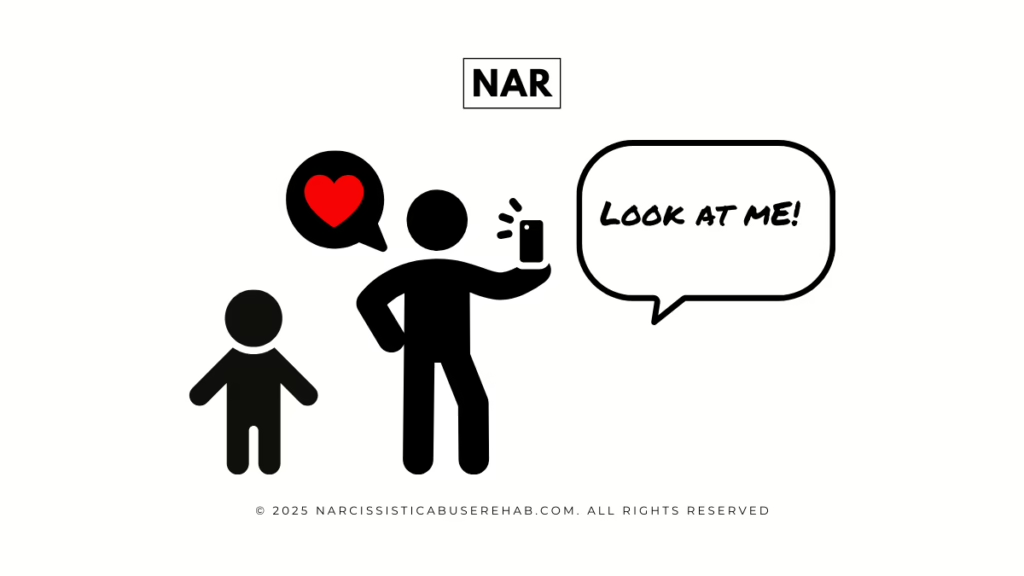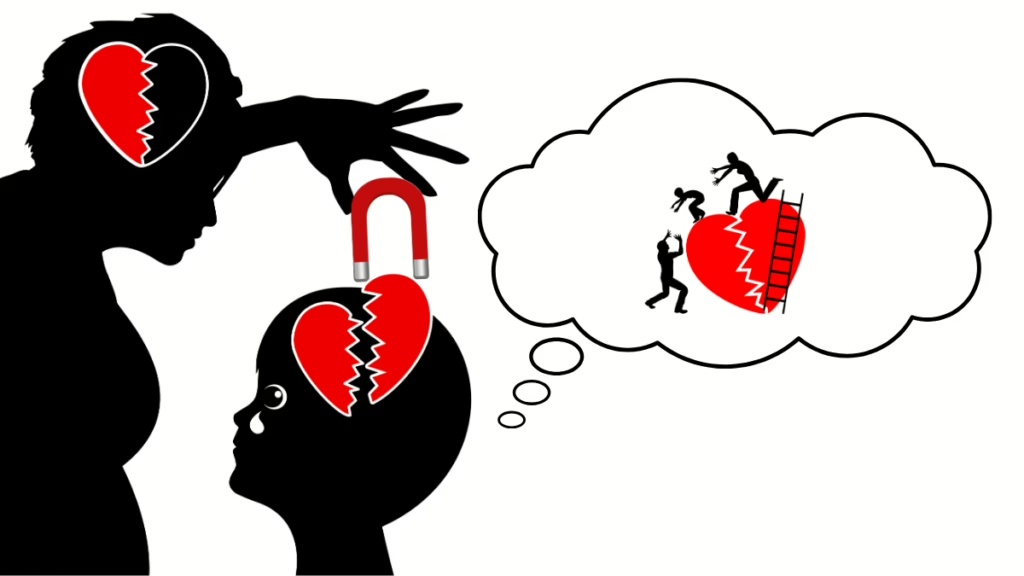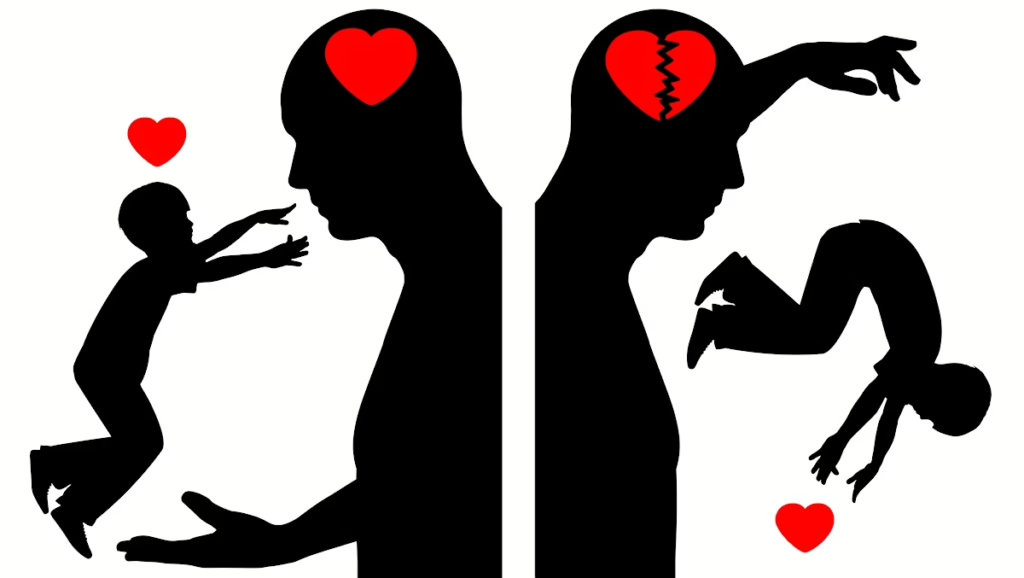The child of a highly narcissistic parent is born into a gaslit reality, in an environment where everything must revolve around their parent’s false self. 1 From an early age, the child must learn to avoid wounding their parent’s fragile ego or risk their parent’s unbridled aggression.2
An excessively self-absorbed parent cannot recognize the emotional needs of their child.3 The more narcissistic a parent is, the more likely they will see their child as an extension of themselves and not as a separate individual.4 The type of parent is prone to take a punitive stance toward attempts by the child to differentiate themselves.5
Highly narcissistic parents master the art of inflicting psychological pain on their children without raising a hand.6 One of the ways they accomplish this is by invalidating the child’s sense of reality through gaslighting, a component of coercive and controlling behavior.7
The cumulative effect of emotional neglect and intermittent reinforcement on children over time can cause the child to suffer depression, anxiety, or post-traumatic stress.8 These conditions can persist long after the child has matured, and they are common among adult children of narcissists (ACONs).
In this article you will learn:
- How The False Self Becomes A False Idol
- Why The Narcissist Engineers Dysfunction
- Why Love is Conditional
- Why Narcissists Reject Children Who Are Not Like Them
- Summary
- Works Cited
1. The False Self Becomes a False Idol

As a parent, the narcissist’s false self becomes a false idol that demands to be worshipped by their family unit.9 Narcissists create glaring power imbalances between themselves, their spouse and children. One moment love is care, safety, and acceptance; the next it is neglect, abandonment, tyranny, and subjugation.
Because the narcissist’s needs supersede the needs of everyone else, the group internalizes the message that their needs don’t matter unless the narcissist says they do.10 If one parent is empathic, it can undermine narcissist undermines their authority and their empathy is punished. The children learn that might is right. They must appease the narcissist if they want to have their needs met.
2. Narcissistic Parents Engineer Dysfunction

Because a narcissistic family unit is an organism that operates in a gaslit pseudo-reality, it is less akin to a family and more like a cult or a dictatorship. In this dynamic, the group can’t be relied on to be supportive, accepting, healthy, or just. Instead, family members behave and interact in unhealthy ways as they scramble to stay in the narcissistic parent’s favor.
The children must learn to navigate the power imbalances and the inevitable abuses of power that ensue. Thus, the default setting for existence in a narcissistic family is dysfunction.
3. Love is Conditional with Narcissistic Parents

Children of narcissists learn that love hurts. A narcissistic parent teaches them that if someone displeases you, it is okay to harm them them and still feel entitled to their devotion and loyalty.11
Narcissistic parents are often displeased when their children are not similar to them. For children of narcissists, one dimension of a narcissist parent’s “love” is having your personality rejected and replaced with one the narcissist prefers. Love is neglect, abandonment, tyranny, and subjugation.
Narcissistic parents sometimes see a child’s individuality as an act of insubordination.
Love is intermittent reinforcement with spouses and children alike.12
The child is love-bombed when the narcissist feels the child reflects their false self. The moment the child fails to do so, the narcissistic parent blithely discards them.
4. Narcissistic Parents Reject Children Who are Not Like Them

Survival in a narcissistic family depends on each family member’s ability to take on and reinforce the assigned roles, toxic attitudes, and habits of the narcissist. No one is safe from a narcissist’s pernicious scrutiny, not even their children.
In the narcissist’s view, anyone who does not echo their image of themselves is rejecting them. Failure to reflect and affirm their false self is a threat. Thus, a child who does not accept the role assigned by the narcissistic parent triggers a narcissistic injury.
A lot of different personalities develop in the narcissist’s ecosystem.
The narcissist cannot process negative feedback, and by extension, nor can their family unit. They have zero tolerance for any person or thing they believe may endanger their fragile false self. When faced with such a threat, narcissists attack — even if the source of their ire is an infant.
Narcissists see a child’s individuality as an act of insubordination. Their response to this perceived narcissistic injury is contempt, oppression, and rejection of the offending child. As an act of expediency, the narcissist casts the child in the psychologically devastating role of the family scapegoat. The narcissist condemns the child to bear the blame for all of the family’s dysfunctional behavior and its outcomes.
Summary
To grow up in a narcissistic family is to grow up in an inverted reality, where right is wrong, and wrong is right. Anything goes as long as you tow the narcissist’s line.
There will be flagrant betrayals, hypocrisy, double standards, cruelty, and abuse. If one of the parents is empathic, the children will get a daily dose of how to manipulate, exploit, and subjugate another human being.
A lot of different personalities develop in the narcissist’s ecosystem. How the child turns out depends on how they navigate the harsh psychological terrain of the family.
How Narcissistic Abuse Rehab Can Help
If you or a loved one is ready to break free from a toxic relationship and reclaim your life, Narcissistic Abuse Rehab is here to kick start your recovery journey. We craft tailored solutions that support your unique path to healing, offering empowering one-on-one coaching sessions every week. Our world-class coaching services employ effective, evidence-based strategies to help you rebuild your inner strength, reconnect with your purpose, and achieve your recovery goals. Experience online support that empowers you to overcome past wounds and embrace a fulfilling future. Book a FREE 15-Minute consultation today.
How to Cite This Article
Wakefield, M. (2020, January 6). 4 Subtle Ways Narcissistic Parents Abuse Their Children. Narcissistic Abuse Rehab. Retrieved on [date] from https://www.narcissisticabuserehab.com/narcissistic-parents
Works Cited
Our commitment to accuracy at Narcissistic Abuse Rehab means we go the extra mile. We adhere to strict sourcing guidelines, prioritizing information from peer-reviewed studies, academic institutions, and leading medical journals. Our articles undergo rigorous fact-checking, often utilizing secondary and tertiary sources to ensure we’re presenting the most reliable and accurate information possible. Our editorial policy explains our process in more detail.
Click to view a list of the works cited in this article.
- Wakefield, M. (2020). The Narcissist’s False Self. Narcissistic Abuse Rehab. ↩︎
- Wakefield, M. (2020). What is a Narcissistic Injury. Narcissistic Abuse Rehab. ↩︎
- Malkin, Craig. Rethinking Narcissism: the Bad — and Surprising Good — about Feeling Special. New York, NY: HarperWave, 2015. ↩︎
- Ibid. ↩︎
- Ibid. ↩︎
- Wakefield, M. (2020). The Coercive Control of Children with Dr. Evan Stark. Narcissistic Abuse Rehab. ↩︎
- Ibid. ↩︎
- Ibid. ↩︎
- Kohut, Heinz. The Analysis of the Self A Systematic Approach to the Psychoanalytic Treatment of Narcissistic Personality Disorders. Chicago: University of Chicago Press, 2013. ↩︎
- Ronningstam, Elsa (2005). Identifying and Understanding the Narcissistic Personality. New York City: Oxford University Press. pp. 22–27. ↩︎
- Ronningstam, Elsa (19 January 2016). “Pathological Narcissism and Narcissistic Personality Disorder: Recent Research and Clinical Implications.” ↩︎
- Kernberg, Otto F. Borderline Conditions and Pathological Narcissism. Lanham: Rowman & Littlefield Publ., 2004. ↩︎
Photos by Deposit Photos. All graphics created by Narcissistic Abuse Rehab are copyrighted and protected by the law. Any unauthorized use, copying, reproduction, or distribution of these materials is strictly prohibited. Violators will be subjected to legal action and protected to the full extend of the law.
For licensing inquiries or permissions, please send a request via our contact page.
This article is also published at Medium.com.





